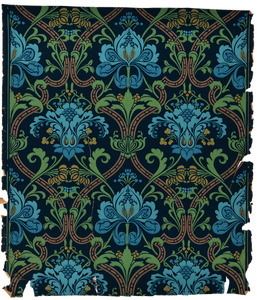Gruesome Greens and Poisonous Petals: Scary Secrets of Wallpaper in the Victorian Home
- ArchiWest

- Oct 27, 2024
- 4 min read
Halloween is just around the corner – spooky season is well underway, and when it comes to buildings there’s nothing that quite says Halloween like the haunted house. While your average historic building might have its fair share of ghosts and ghouls, the décor of the past could create a whole different type of housebound horror, which is useful to know when embarking on your own Victorian home restoration project...

In the studio recently we’ve been refreshing our knowledge on the hazards and Health and Safety issues faced in historic buildings, and there was one grizzly hazard in particular that caught our attention. If you’ve been rattling through the scary movies this Halloween season, you might have noticed a trend. From the Amityville Horror in the 1970s, through to more family-friendly romps like Monster House, it is a long-standing trope for a malevolent house to be the main villain itself, haunting and terrorising its inhabitants. Back in the real world, you only have to look back to the Victorian era for there to be a real threat that your house – your WALLPAPER, specifically – could be out to get you.
In the Victorian era, two trends combined to create a deadly addition to the interior of countless homes. The first factor in this dangerous duo was the colour green. Green was a mainstay of Victorian home décor, with the rich hues of Scheele’s Green – a shade invented by Swedish chemist Carl Scheele – mimicking the greens found in nature. The shade became highly in vogue with the Victorian elite, and the rise of the Romantic movement only furthered the desire to cover one’s home with glorious green wallpapers. But why did this create such a…toxic environment in these homes? The second factor in this problematic pairing was what was being used to make these vibrant green tones; arsenic.
Above left - Jeffrey & Co. wallpaper c1900 which when XRF tested contained arsenic
Above right – Illustration of typical green Victorian decor
Arsenic was hard to avoid in Victorian society. The poisonous by-product of copper, lead, and tin mining could be found in everything from cleaning products to candles. Its grasp on the Victorians was so strong that it was even used medicinally, with products like Fowler’s Solution hailing themselves as miracle cures for an array of ailments.
This Victorian penchant for poison and the mid-19th century obsession with green bought arsenic into the home. Even if you bucked the trend and eschewed the gaudy greens, arsenic was also used to make blues and yellows, and to enhance other shades such as pinks and reds. Living in these arsenic-adorned rooms could cause all sorts of grim symptoms – headaches, vomiting, lesions, and in the worst cases death, and children were most at risk of suffering the worst of these symptoms. Doctors began to make the link between these symptoms and wallpaper in the late 1860s, and despite increasing anxiety amongst the public about the poisons that surrounded them, moving away from the arsenic stronghold was a slow process. William Morris’ wallpaper designs are some of the most iconic and easily recognised from this period, however he was in no rush to remove arsenic from his wallpapers and was openly sceptical about the dangers arsenic presented. The doctors of the time, Morris believed, had been ‘bitten as people were bitten by the witch fever’.

The Arsenic Waltz 1862 (https://wellcomecollection.org/works/awbr7whm)
However, by the late 1870s public pressure had won out and wallpaper manufacturers were moving away from arsenic – Morris included, even though he continued to assert his scepticism. Once the tide had turned, it was not uncommon for wallpaper manufacturers to proudly emphasize ‘Free From Arsenic’ in their advertising. By 1900, British wallpaper was deemed to be ‘practically’ free of arsenic in a Home Office report.
As much arsenic wallpaper was removed when the dangers of it became known (including those in Buckingham Palace in 1879), it is relatively unlikely you’ll stumble across this haunting hazard in your historic home. Research by Historic England and the National Archives using X-ray Fluorescence analysers has started to identify different patterns that used arsenic from remaining scraps that have been found and from sample books held in archives. While these Victorian wallpapers were undeniably beautiful, they were also undeniably dangerous, and greater understanding of the risks they presented helps keep us safe when working and living in Victorian buildings.
Article credit: Bronte Fry (ArchiWest)
If you are embarking on a Victorian home restoration project this Halloween and discover historic wallpaper in your home, it would be highly advisable to understand the risks and seek specialist advice before potentially disturbing it.

At ArchiWest our Heritage specialists are able to carry out extensive reporting on Victorian homes and historic building restorations, that may also include areas of potential concern for further investigation. For more information and help with your project get in touch here.
Further reading about historic Victorian wallpaper and arsenic in architecture can be found using the links below;
https://www.smithsonianmag.com/smart-news/victorian-wallpaper-got-its-gaudy-colors-poison-180962709/
studio@ArchiWest.co.uk - 01934 311017









Kommentit